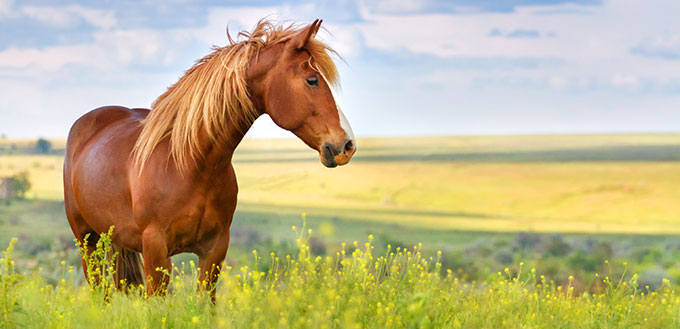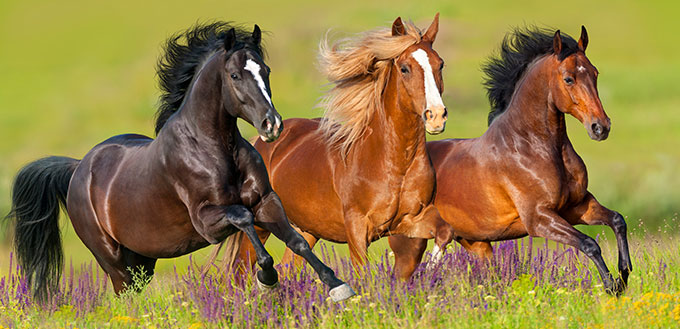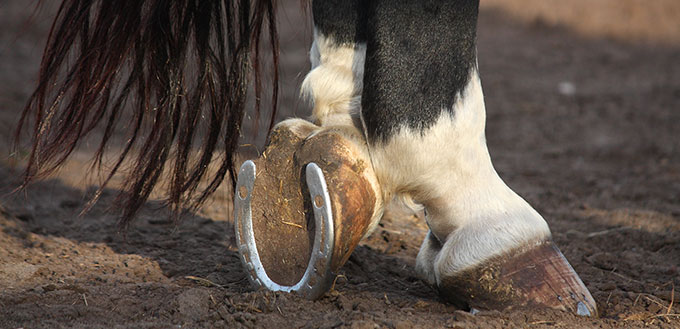Increasingly common as a point of debate among horse owners and horse lovers, arguments for both sides are pretty compelling. As with all things, of course, understanding the pros and cons behind whether or not to shoe horses or leave your horse unshod (without horseshoes) is key to choosing the best option for your horse’s hooves. So for those wanting to understand the benefits of shoeing a horse and the pros behind horseshoes and horses’ hooves, this article is for you.
What Exactly is a Horseshoe?
What did we do before shoes for horses were made?
Wild and domesticated horses have very different needs – particularly as domesticated horses became relied upon much more over time to complete tasks such as farming. Indeed, horses have been a staple of our lives for thousands of years. Some of the earliest indications of horseshoes being used go as far back as 400 BC.
Clearly, earlier humans understood that horse hooves need to be protected for the good of both hoof health and to soothe existing injuries in the horse’s foot and legs. Effectively, the more we began to use the humble horse for work and to ride, the more we saw that our animal friends needed properly fitted horseshoes.
There’s very little time (that we currently know of) between horses becoming domesticated and the use of shoes. Since the horse’s hoof wears down quickly, in the same way that the human fingernail would if it were regularly working against the stony ground, hoof problems were most certainly afoot.
The quickly wear and tear meant that lameness issues would become common. Even the simplest injury would lead to pain and more harm over time. So, the horseshoe was created to help protect the horse’s hoof.

When Were Horseshoes Invented?
Each source varies on when the horseshoe was invented. Interestingly, before the horseshoe itself, horses wore hoof boots made from leather. These were used as far back as 2500BC when horses were used in war, and the use of chariots required protective footwear for their horses.
Back then, the materials weren’t made from metals as they are now. Instead, everything from plants to rawhide was used, with the Ancient Asians weaving plants together to create soothing, corrective shoeing, temporary protection, and additional traction.
Overall, the consensus seems to be that horses have been wearing shoes since roughly 400 BC. Most notably by the Romans, who called the shoes “hipposandals”. But (!) horseshoes, in general, were not truly widespread until roughly 1000AD, which means that barefoot horses were more common than shoed (or shod) horses.
After this point, many differences were added to the shoe itself. Different types were made for different purposes, and nail holes were added to help attach the shoe to the horse’s feet. By the 14th century, horseshoes had eight holes, and the structure of the shoes was wider and heavier.
By the time the industrial revolution was fully blazing, shoeing horses was essential for work and the machines themselves could mass-produce shoes. Indeed, this came in handy during the American Civil War since the properly shod horse hooves provided a distinct advantage in battle.
What Are Horseshoes Made Of?
Original shoes may have been made from the most basic of materials – but they quickly advanced to better suit the horse’s needs. These days, however, traditional horseshoes are most frequently made from aluminum or steel, although the strength and quality differ, depending on use.
There are also many specialized types of a horseshoe, which can use anything from rubber or plastic to magnesium, titanium, or copper.
How Are Horseshoes Fitted?
When horses need shoes, they require the skills of an experienced farrier, who can measure the hoof. This is because they’ll need to know the depth and width, as well as the height of the hoof, so the right shoes can be ordered or made for your horse. Not only will the shoes need to fit well, but the nails used by the farrier should be the right length to avoid foot problems later.
A good farrier will also ask you questions to understand the needs of the shoes required. If you are looking for a farming horse (for example), you would not only need shoes that can carry the extra weight of pulling, but the shoe would need to provide extra traction to make their work easier.
Similarly, for trail riding, the shoes would need to avoid common mistakes that can place extra pressure on the leg or cause your horse to become too uncomfortable when you’re out riding. In these cases, it’s not just about providing traction, but promoting the health of the foot and leg, too.
In terms of fitting, the farrier is incredibly skilled at ensuring the long-term health of your horse.
The farrier will help to make sure the shoes are comfortable for longer wear and tear by first maintaining regular trimming using a hoof knife. Once the hoof has been trimmed, the shoe is placed against the feet, and nails are used to attach the shoe to the foot.
Once the nails are placed near the outer edge of the hoof, the farrier then bends them over, which creates a hook-like fit. At this point, the farriers file away the sharp points to avoid any accidents or infections around the foot.
Over time, the hoof will grow out, eventually overlapping the shoe. This is a sign that new shoes need to be fitted against the horse! If you want to learn more about this topic, see our article on How to Shoe a Horse.
How Do Horseshoes Work?
Interestingly, there are different types of horseshoe depending on the needs of the horse and rider or master. For riding, farriers need to consider speed and agility while remaining safe for both horse and owner.
Regardless of the type of shoe, however, it’s important to note that horses need shoes to maintain the overall health of their hooves, feet, and legs. They do this by improving the overall durability of the hooves and soft tissue beneath, which can be revealed over time if the horses are left barefoot.

Different Types of Horseshoes
Regular Shoes
The regular horseshoe is the one you’ve probably already seen anywhere and everywhere. They are the kind of shoe you see as a good luck charm, and the majority of horses will never need anything more than this, particularly if the horse is only used for general riding purposes. They help keep great feet healthy and happy but don’t work as effectively as traction devices.
Rim Shoe
The rim shoe takes the standard groove present in the regular shoe and makes it much deeper. While the regular shoe uses the groove to maintain an evenness between the shoe and the nail used to keep the shoes in place, a rim shoe offers much more. This helps creates more traction and are great for maintaining arena footing, as the turns are much quicker and speed much greater, using these shoes on foot.
Bar Shoe
The bar shoe is developed to look more circular and has a constant strength around the entire frame. The extra “bar” on the rear helps maintain the foot’s integrity – particularly for horses who have developed injuries, such as damage around the navicular bone or problems from being barefoot for longer periods of time.
Egg Bar
The egg bar is a deeper, more rounded shoe that extends beyond the heel and offers greater support and protection. The structure’s higher and wider design means that horses with badly damaged feet from being barefoot for longer than usual or through an injury such as navicular disease can be more comfortable and secure.
Heart Bar
The heart bar shoe offers the benefits of all of the above options – but comes with an extra section designed to support the frog, as well.
There is very little difference between the front and the rear in all of these shoes. The only difference might be the shape – but this is often negligible and counteracted through the farrier’s skills.
Why Do Horses Wear Shoes?
Horses wear shoes for many reasons – but the most important and notable reasons are that:
They Provide Better Traction
Using the right horseshoe at the right time means you can ensure that your horse is offered the right amount of traction. This, in turn, stops any additional strain against the legs of your horse and keeps them healthier and happier for longer.
They Help to Maintain the Health of the Foot and Supporting Body Parts
As mentioned above, traction works wonders to keep your horse healthy. But some horseshoes allow your pet to stretch a little and bounce, naturally, without overdoing themselves, which can often cause harm.
They Help to Evenly Distribute Weight Across the Feet of the Horse
Your horse’s hooves are designed to bend slightly when riding – but too far, and they’ll cause damage. Using a horseshoe helps evenly distribute weight, which not only stops certain sections of a barefoot horse from overexpanding but also keeps the supporting muscles and bones healthier, too.
They Increase Protection Against Impacts on the Road or Ground
Shoes are designed to be the first impact when hitting anything sharp or hard while riding. While boots can do a good job against some of the items you’ll come across in your travels; a good quality shoe will be much better equipped to reduce the impact of sharp and dangerous objects.
Horseshoes vs. Barefoot: What’s Better for Your Horse?
Generally speaking – especially when it comes to working horses – having horseshoes is much better than being unshod. This is particularly true when it comes to corrective shoeing and ensuring your horse’s overall health.
As well as the many benefits given above, maintaining your horse will eventually come as second nature to you. You’ll quickly be able to see if something is wrong when you’re regularly working to re-shoe your pet. Effectively, of course, it all comes down to personal preference and what’s best for you and your horse.
That’s not to say, of course, that barefoot horses don’t have their time and place.
Many Arabian horses live their full life without the need to wear shoes. However, it should be noted that these horses build up a tougher hoof over time. As such, anyone considering leaving their horse unshod should be sure that they’re able to work with their horses to maintain their overall health and wellbeing.
Firstly, consider their environment.
If your horse spends the majority of time on softer grounds, such as on grassy pastures, they’re much less likely to develop tougher hooves. So, when it comes to harder grounds, you’ll find that your horse struggles much more and is more likely to suffer from health problems around the hooves and feet.
Then, consider their workload.
If you still want to continue helping your horse to remain unshod, then be sure to keep them away from any work for at least 30 days while they adapt. Expert opinions on whether hoof boots work seem to vary, with some claiming the boots cause horses to take longer to develop tougher hooves. While others suggest, it may help them to adapt.

FAQs:
Q: Why do wild horses not need shoes?
A: Put, wild horses, do not have the same pressures on them as domesticated horses do and therefore have less need to wear shoes. More importantly, wild horses will build up resilience in their hooves as they walk across the dirt and over softer ground – but very rarely walk on hard ground.
If wild horses were to suddenly travel longer distances or need to walk over harder surfaces, they would also need shoes to protect their feet. However, going barefoot does not harm a horse who doesn’t have to work with extra weight, trail riding, or generally being put to work by humans.
Q: Does putting horseshoes on a horse hurt them?
A: If you’re using a good farrier, you can be sure that putting shoes on the hoof of your horse does not hurt them. Since the shoeing requires finding the right shape, material, and design, combined with well-trimmed feet, there’s less risk of causing your horse pain through shoeing than having your horse go barefoot.
This is not to mention that skilled farriers are well-versed in fitting the animals with their shoes. For most horses, having a shoe fitted to their hoof is akin to having someone put some pressure on your nail. The bone itself – the coffin bone – and the hoof wall (which acts as a nail) don’t feel anything as there are no nerve endings here.
A farrier who is not skilled is more likely to miss this part of the hoof and could hit the more sensitive areas of the horse’s feet, such as the frog.
Of course, a farrier who is inexperienced with horses may also pose a risk to themselves. If other horses become scared or aren’t used to the feeling of having a shoe fitted or their feet trimmed, then there’s an increased risk of the horse becoming spooked.
When this happens, you need an experienced farrier to know exactly how to work with the horse to keep them at ease and ensure neither the farrier nor the horse while shoes are put on the horse.
Q: Why does my horse keep losing shoes?
A: There could be a couple of reasons as to why you suddenly find your horse without hoof protection.
For starters, the shoe itself might be of poor quality
Poor quality shoes can twist and lose their shape, becoming more worn more quickly and offering little protection or traction for your horse. For this reason, it’s important to check the feet and hooves of your horse before taking them out for a ride.
The hoof has grown
Easily the most common cause for why most horses will lose their shoe is simply because their hooves have grown. The nails are slowly pushed out of place when this happens, and the shoe comes loose. However, it should also be noted that, before this happens, riders should be aware that loose shoes are likely to trap mud and debris from soft ground. As such, owners should check their horses regularly.
Normal wear and tear
Put simply, over time, there will be general wear. Shoes, therefore, are more likely to come loose from general use – regardless of the type of ground you ride on. But, of course, this will also largely depend on how often and how far you travel while riding.
Q: At what age should you shoe a horse?
A: A lot of this comes down to personal preference. If you’ve read the above and would prefer to wait before having your horses wear shoes, then that’s what you should do. Wearing shoes isn’t necessary for as long as the hoof is in good condition. Because of this, a foal won’t need to wear shoes until you begin training them. Just be sure to keep an eye on your horse and its hooves.
Q: How long do horseshoes last?
A: The answer to this depends on your horse. Very young horses will need their shoes changing much more regularly than fully-grown horses. Also, since horseshoes are attached via the nails into the hoof wall, the nails will become loose as the hoof grows.
As such, the shoe becomes loose and less effective, and more uncomfortable for your horse. Because of this, younger horses often need their shoes changed more frequently.
At the same time, it’s important to remember that horses hooves are much like a fingernail and will continue to grow. So, generally speaking, every six weeks is frequent enough to keep the hooves in top condition. Just be sure to trim the foot, too.
Note: The advice provided in this post is intended for informational purposes and does not constitute medical advice regarding pets. For an accurate diagnosis of your pet's condition, please make an appointment with your vet.







